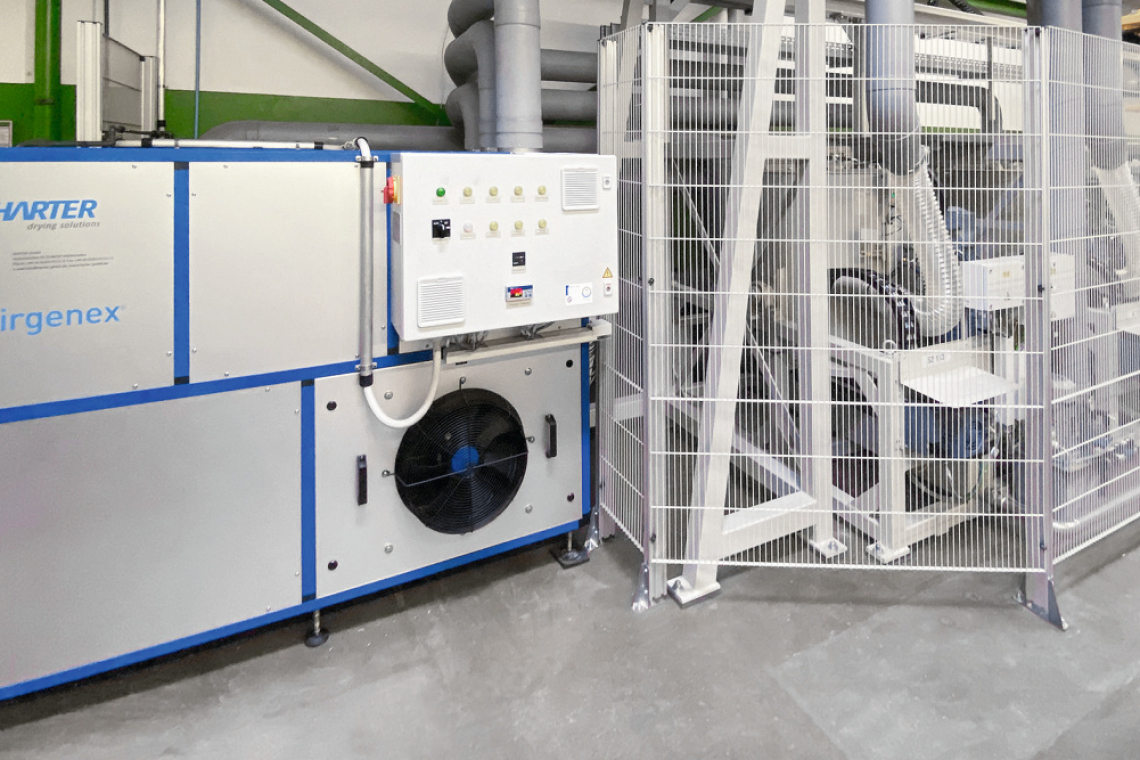Anyone who uses centrifuges knows about the issues associated with hot air drying: thermal stress on the parts, cooling required, high energy costs. A project with heat pump drying shows that there are other options and how they can be implemented.
Hubert Stüken GmbH & Co KG, or Stüken for short, from Rinteln, a manufacturer of precision deep-drawn parts, stamped parts and assemblies, was using outdated centrifuges for its production. Components treated in the electroplating shop were heated for 30 minutes with a lot of hot air and then required a longer cooling phase before they could be packaged. The process was cumbersome and costly "We wanted to automate this entire process," explains Dr. Christopher Bruns, project engineer at Stüken, "and replace the previous drying process with a modern technology."
To this end, Stüken brought plant manufacturer WMV on board, who in turn commissioned dryer manufacturer Harter. Together, they realized the pilot project "Energy-saving centrifuge drying" and thus created a basis for future cooperation in this area. Stüken himself had already been familiar with Harter's energy-saving heat pump drying system for some time, although at that time it was a drum drying system.
WMV
WMV is a global plant manufacturer in the field of surface treatment, cleaning and coating. The company offers a wide range of technologies, from oil removal and washing to drying and coating of bulk parts and rack goods.
With the integration of electroplating systems since the beginning of 2023, WMV is expanding its portfolio to offer the entire surface treatment process chain seamlessly from a single source. This means that all processes can be optimized with WMV technology in terms of flexibility, speed and energy efficiency.
Trials and air
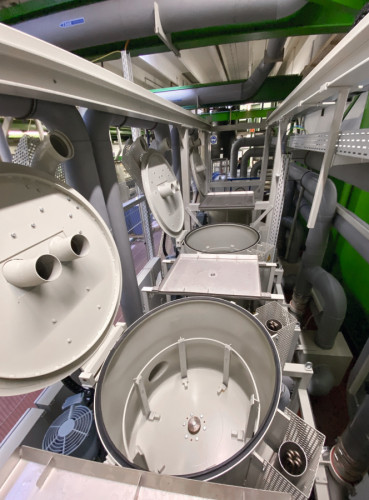 Three new swivel centrifuges were installed at Stüken, which dry components in the low-temperature range to save energy. Automated lids keep the heat in the systemForStüken,saving energy was the top priority, directly followed by the desire for drying in the low-temperature range. Harter always tests whether and how the relevant components behave during heat pump drying in its in-house technical center. WMV also has an in-house technical center in which all relevant processes in the field of centrifuge technology can be applied. "Accordingly, we have tested the components from Stüken extensively and continuously in our technical center with a heat pump module from Harter," reports Sascha Meuser, responsible for project planning and sales at WMV. "This means we can now carry out test series with centrifuges and heat pump drying for interested customers in the future."
Three new swivel centrifuges were installed at Stüken, which dry components in the low-temperature range to save energy. Automated lids keep the heat in the systemForStüken,saving energy was the top priority, directly followed by the desire for drying in the low-temperature range. Harter always tests whether and how the relevant components behave during heat pump drying in its in-house technical center. WMV also has an in-house technical center in which all relevant processes in the field of centrifuge technology can be applied. "Accordingly, we have tested the components from Stüken extensively and continuously in our technical center with a heat pump module from Harter," reports Sascha Meuser, responsible for project planning and sales at WMV. "This means we can now carry out test series with centrifuges and heat pump drying for interested customers in the future."
Energy savings were the top priority for Stüken
In these test series, the parameters relevant for successful drying were determined. These are the feasibility as such, the specified time, the moisture supply, the exact temperature and everything that revolves around the air. Reinhold Specht, Managing Partner at Harter, describes this as follows: "These factors include the air volume flow, the air speed and, of course, the air flow. It plays a key role in success, because only if the air is guided through the material to be dried in a targeted manner can it dry homogeneously."
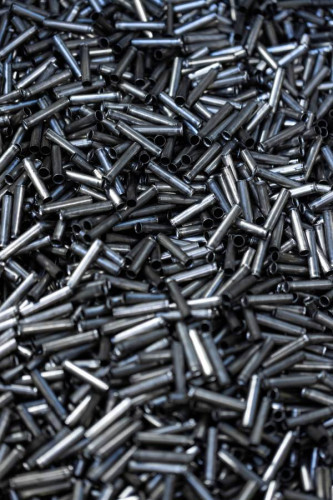 Bulk materials like these are dried in the centrifuges
Bulk materials like these are dried in the centrifuges
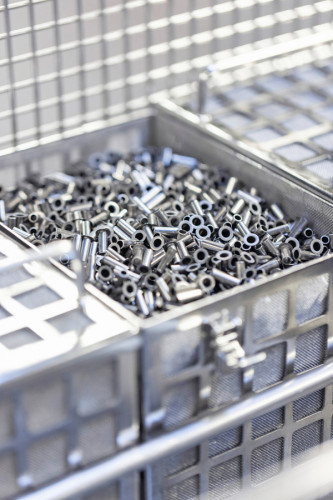 New system with heat pump Three new swing centrifuges have now been installed at Stüken and equipped with heat pump technology. On the one hand, this means that a special circulating air fan has been connected to each centrifuge housing. These fans are responsible for optimum air circulation in the centrifuge body. They are EC fans that are infinitely variable. Secondly, the swivel centrifuges were then connected to a heat pump module via air ducts. The heat pump module prepares the required process air and is also responsible for the condensation process. At Stüken, one module supplies all three swing centrifuges. The drying system was implemented in accordance with Stüken's performance specifications. It is designed in such a way that it can dry the goods gently and in an energy-saving manner for two electroplating lines. Each of the three swivel centrifuges used can be adapted to Stüken's wide range of parts. The speed, angle of inclination and number of circulation cycles are matched to the geometry of the fabric according to the parameters and process cycles. This combination of swivel centrifuge and hard heat pump technology utilizes the advantages of both processes: Process cycles, spinning off and recirculation as well as energetic condensation drying in the low temperature range.
New system with heat pump Three new swing centrifuges have now been installed at Stüken and equipped with heat pump technology. On the one hand, this means that a special circulating air fan has been connected to each centrifuge housing. These fans are responsible for optimum air circulation in the centrifuge body. They are EC fans that are infinitely variable. Secondly, the swivel centrifuges were then connected to a heat pump module via air ducts. The heat pump module prepares the required process air and is also responsible for the condensation process. At Stüken, one module supplies all three swing centrifuges. The drying system was implemented in accordance with Stüken's performance specifications. It is designed in such a way that it can dry the goods gently and in an energy-saving manner for two electroplating lines. Each of the three swivel centrifuges used can be adapted to Stüken's wide range of parts. The speed, angle of inclination and number of circulation cycles are matched to the geometry of the fabric according to the parameters and process cycles. This combination of swivel centrifuge and hard heat pump technology utilizes the advantages of both processes: Process cycles, spinning off and recirculation as well as energetic condensation drying in the low temperature range.
In practice, this means a total drying time of 5 to 16 minutes, depending on the item to be dried. This time is made up of a cycle time of three to 14 minutes, minus two minutes of overheating time. Each centrifuge station is equipped with an automatic lid that only opens when the centrifuges are moved in and out. This keeps the valuable heat in the system. The components are dried gently and homogeneously at 50 °C. The centrifuges rotate at specific intervals. These are matched to the components via PLC control. The centrifuge stations are also equipped with an electric heater. This is only used for components that require a higher drying temperature. According to current estimates, this will be the case for around 25% of the entire parts portfolio. The energy-saving drying system has a nominal output of around 12.5 kW in production mode.
Harter
Harter entered the market in 1991 with its specially developed condensation drying system with heat pump. Initially, the focus was on drying filter-pressed sludge and thus reducing disposal costs. Dehumidification in the low-temperature range was quickly expanded to include the meticulous drying of components. Today, in addition to the broad spectrum of surface technology, Harter has other mainstays in the fields of medical technology, pharmaceuticals, medical cannabis, food, animal feed and packaging. With a pilot project in the field of sewage sludge drying, Harter has been building up a further business segment since last year.
Dehumidifying and conveying air
Harter systems work with extremely dry process air. If air is very dry, it is unsaturated and, for physical reasons, absorbs moisture very quickly. The drying system manufacturer has been taking advantage of this fact for over 30 years. "We guide the dry air over or through the products and can therefore dehumidify them extremely quickly," says Specht. However, the air must be directed precisely, as otherwise it follows the path of least resistance. Harter only achieves success with this combination. "A lot of experience and expertise goes into the right air routing," adds Specht. In 2017, the Harter drying technology was classified by the government as a future technology and therefore eligible for funding. Since then, operators have been able to apply for funding for this heat pump drying system.
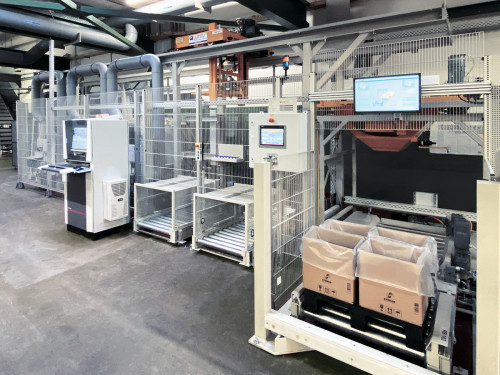 Production line at Stüken with WMV system technology
Production line at Stüken with WMV system technology
All three parties are now very satisfied with the collaboration and the high-quality drying results. "It can continue like this in the future," says Meuser with a grin. "As a system manufacturer, we are also very happy to be able to offer our customers more high-quality technology."
Stüken
Founded in 1931, Stüken is now regarded as the world's leading supplier of precision deep-drawn metal parts. Almost 40 billion deep-drawn parts are produced annually at the main plant in Rinteln alone. The product range also includes stamped and stamped-bent parts, plastic-coated components and sophisticated assemblies.
The products are used in a wide range of applications, from household appliances to fittings, computers, cell phones, medical products and motor vehicles. The family-owned company has subsidiaries in the USA, the Czech Republic and China - with another production site in India already being planned.
Photos: Harter

